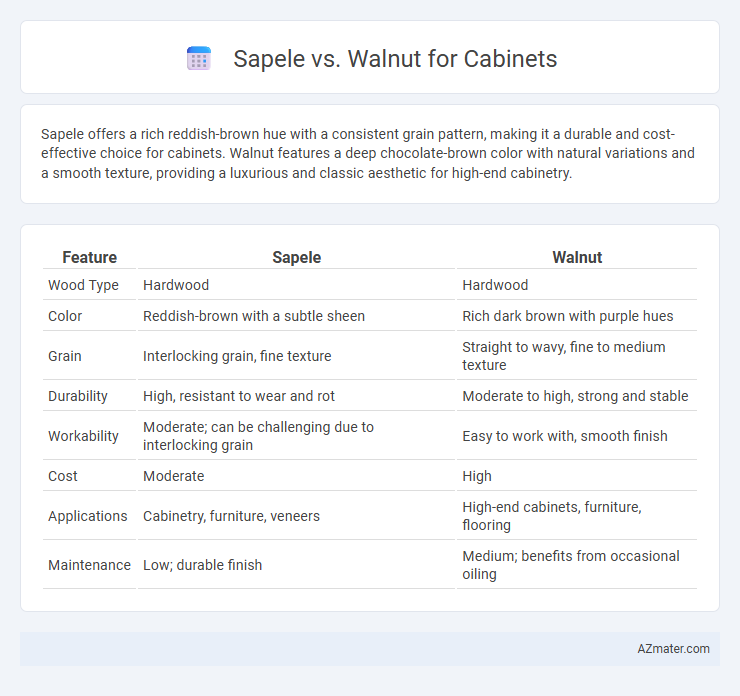Sapele offers a rich reddish-brown hue with a consistent grain pattern, making it a durable and cost-effective choice for cabinets. Walnut features a deep chocolate-brown color with natural variations and a smooth texture, providing a luxurious and classic aesthetic for high-end cabinetry.
Table of Comparison
| Feature | Sapele | Walnut |
|---|---|---|
| Wood Type | Hardwood | Hardwood |
| Color | Reddish-brown with a subtle sheen | Rich dark brown with purple hues |
| Grain | Interlocking grain, fine texture | Straight to wavy, fine to medium texture |
| Durability | High, resistant to wear and rot | Moderate to high, strong and stable |
| Workability | Moderate; can be challenging due to interlocking grain | Easy to work with, smooth finish |
| Cost | Moderate | High |
| Applications | Cabinetry, furniture, veneers | High-end cabinets, furniture, flooring |
| Maintenance | Low; durable finish | Medium; benefits from occasional oiling |
Introduction: Sapele vs Walnut for Cabinetry
Sapele and walnut are both popular hardwood choices for cabinetry, valued for their durability and rich appearance. Sapele offers a reddish-brown hue with a distinctive interlocking grain, enhancing cabinet aesthetics with a warm, exotic look. Walnut provides a deep, chocolate-brown tone and smooth grain, praised for its timeless elegance and ability to complement various interior styles.
Wood Origins and Botanical Differences
Sapele wood, derived from the African rainforests primarily of West Africa, belongs to the genus Entandrophragma and is closely related to mahogany, featuring a distinctive interlocking grain that enhances durability and aesthetic appeal. Walnut, native to regions of North America, Europe, and Asia, comes from the Juglans genus, prized for its straight grain and rich, dark brown color with occasional purplish hues. The botanical differences impact cabinet making, with Sapele's denser, harder texture offering superior resistance to wear, while Walnut's fine, even texture allows for smooth finishes and intricate woodworking.
Color and Grain Comparison
Sapele wood features a rich reddish-brown color that deepens with age, offering a warm, vibrant hue compared to walnut's darker, chocolate brown shade with subtle purple undertones. The grain of sapele is typically interlocked and ribbon-like, providing a striking, wavy pattern, whereas walnut displays a straight to slightly irregular grain with a smooth, satiny texture. These color and grain differences make sapele ideal for bold, decorative cabinetry, while walnut is preferred for classic, elegant finishes.
Durability and Hardness
Sapele wood offers high durability and a Janka hardness rating of approximately 1,410, making it resistant to dents and scratches, ideal for cabinet construction. Walnut, with a Janka hardness of about 1,010, is softer than Sapele but provides excellent stability and a smooth finish, often chosen for its rich color and fine grain. While Sapele excels in hardness and resistance to wear, Walnut is preferred for applications requiring more workability and a luxurious appearance in cabinetry.
Workability and Machining
Sapele offers excellent workability due to its fine, uniform texture and interlocking grain, making it resistant to tear-out during machining and allowing for smooth finishes. Walnut, while slightly softer, machines cleanly but can be prone to fuzzing or chattering without sharp tools and proper feed rates. Both woods hold screws and nails well, yet walnut's lower density makes it easier to shape and carve for detailed cabinetry work.
Cost and Availability
Sapele wood generally costs less than walnut, making it a more budget-friendly option for cabinetry without sacrificing durability. Walnut is often priced higher due to its rich color and grain pattern, which are highly sought after for premium cabinetry. Availability of sapele is typically better as it is more widely harvested and imported, while walnut can be limited and more expensive depending on the region.
Sustainability and Environmental Impact
Sapele wood, sourced responsibly from West African forests, offers a more sustainable alternative to Walnut due to its faster growth rate and certifications like FSC promoting ethical forestry. Walnut, predominantly harvested in North America, faces higher environmental scrutiny because of slower growth and limited reforestation efforts. Choosing Sapele for cabinetry reduces ecological footprint by supporting renewable resources and minimizing habitat disruption compared to the environmental impact linked with Walnut extraction.
Finishing and Maintenance
Sapele wood offers a rich reddish-brown finish that deepens with exposure, providing a warm, glossy surface when sealed and polished, while walnut boasts a naturally dark, chocolate-brown hue that highlights its fine grain with minimal finishing. Maintenance for Sapele requires regular cleaning and occasional refinishing to preserve its sheen and prevent dryness due to its semi-open grain. Walnut cabinets demand less frequent upkeep as their dense, closed grain resists moisture and scratches better, maintaining their elegant appearance with basic dusting and periodic oiling.
Design Versatility and Aesthetic Appeal
Sapele offers a rich reddish-brown hue with a fine, interlocking grain that enhances design versatility, fitting well in both traditional and modern cabinet styles. Walnut stands out for its deep chocolate-brown tones and straight grain, providing a luxurious and timeless aesthetic appeal that complements contemporary and classic interiors alike. Both woods deliver unique visual textures, but Walnut's consistent color and smooth finish often make it the preferred choice for upscale cabinetry.
Which is Better: Sapele or Walnut for Cabinets?
Sapele and Walnut both offer durable hardwood options for cabinets, but Walnut excels in rich color variation and fine grain patterns, making it ideal for high-end, visually striking cabinetry. Sapele provides a more affordable choice with good durability and a reddish-brown hue that darkens over time, suitable for traditional and contemporary styles. For premium cabinetry requiring elegance and unique character, Walnut is generally preferred, while Sapele suits projects prioritizing budget and consistent aesthetics.

Infographic: Sapele vs Walnut for Cabinet
 azmater.com
azmater.com